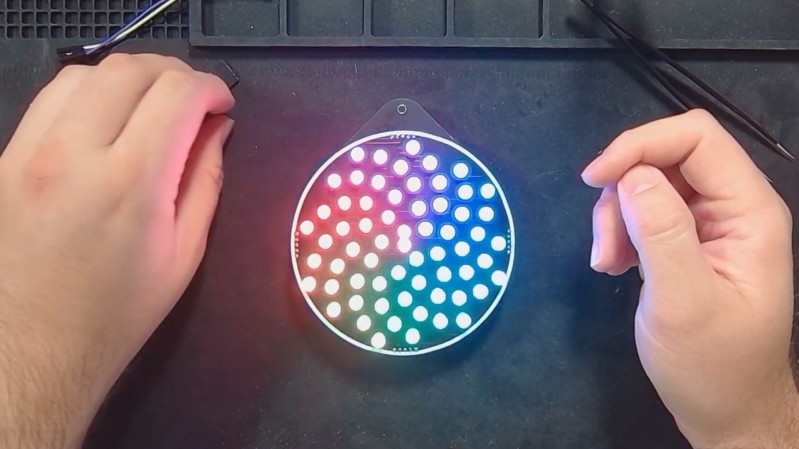Fibonacci numbers are seen in the natural structures of various plants, such as the florets in sunflower heads, areoles on cacti stems, and scales in pine cones. [HackerBox] has developed a Fibonacci Spiral LED Badge to bring this natural phenomenon to your electronics.
To position each of the 64 addressable LEDs within the PCB layout, [HackerBox] computed the polar (r,θ) coordinates in a spreadsheet according to the Vogel model and then converted them to rectangular (x,y) coordinates. A little more math translates the points “off origin” into the center of the PCB space and scale them out to keep the first two 5 mm LEDs from overlapping. Finally, the LED coordinates were pasted into the KiCad PCB design file.
An RP2040 microcontroller controls the show, and a switch on the badge selects power between USB and three AA batteries and a DC/DC boost converter. The PCB also features two capacitive touch pads. [HackerBox] has published the KiCad files for the badge, and the CircuitPython firmware is shared with the project. If C/C++ is more your preference, the RP2040 MCU can also be programmed using the Arduino IDE.
For more details on beautiful RGB lights, we’ve previously presented Everything You Might Have Missed About Addressable LEDs, and for more details on why they can be so fun to wear, check out our Hackaday Badgelife Documentary.
(Editor’s note: HackerBox makes and sells kits, is run by Hackaday Contributor [Joseph Long] IRL.)
















Just note that lead is a neurotoxin and may cause cancer. I’d rather wear a toilet seat rather than piece of lead on my neck.
Lol.
Go and think of the children somewhere else, Karen.
The explanation for the Fibonacci series in nature:
https://www.youtube.com/watch?v=sj8Sg8qnjOg
Surprised that Hackaday never covered Jason Coon’s Fibonacci creations, the likely inspiration for this product. https://www.evilgeniuslabs.org/
I’m also surprised! But they’re hella cool.
And powered by PixelBlaze to boot. (https://electromage.com/pixelblaze)
Thanks Adrian & Elliot!
I’d be remiss if I didn’t mention Jim Bumgardner, whose amazing work inspired my first forays into Fibonacci & Fermat spiral LED displays.
https://www.youtube.com/watch?v=_rt1cqsU8fo
There is mess in the instructable. A Fibonacci spiral is ‘expanding’ more and more quickly. The LEDs layout is NOT using this pattern. The spiral used in this layout is a Fermat spiral. It is ‘expanding’ less and less every turn. The LEDs are placed along the Fermat spiral at fixed angle from previous one. This angle can be related to Fibonacci, but this is not the Fibonacci spiral, and the instructable is mixing different objects. Approximative maths are not maths. What’s the point of mixing those objects? Pseudo scientific marketing for the board?
So pretty 😍